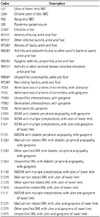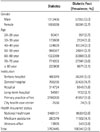Abstract
Purpose
To investigate the prevalence and the current status of treatment of diabetic foot in Korea using Medicare claim data provided by the Health Insurance Review and Assessment Service.
Materials and Methods
Diabetic foot patients were selected from the 2011 one-year data with disease classification code based on the Korean Statistical Classification of Disease and Related Health Problems-6 system. Diabetic foot patient was defined as an adult (> 19-year-old) with specific disease codes of diabetic foot or with disease codes of diabetes, with foot ulcer/gangrene. Treatments for diabetic foot from the 5-year data between 2007 and 2011 focused on wound care including orthopedic foot surgery, lower extremity (LE) arterial revascularization procedure and major LE amputation.
Results
Diabetic patients in 2011 were 3763445, and diabetic foot patients were 108346 (2.9%). In the treatment details for the diabetic foot patients, local wound care alone were included in 104430 patients (96.4%), LE revascularization procedures were included in 2782 patients (2.6%) and major LE amputation were included in 1260 patients (1.2%). Of patients with major LE amputation, 1134 (90.1%) had no record of LE revascularization procedure. Of patients who had LE revascularization procedure, 126 (4.5%) had major LE amputation.
Conclusion
The annual prevalence of diabetic foot in 2011 in South Korea was 2.9%, which was similar to findings of other prevalence study of western countries. LE arterial revascularization procedure was performed in only a minority of diabetic foot patients. There is lack of awareness of LE arterial occlusive disease and the necessity of revascularization in treatments of diabetic foot.
Figures and Tables
Fig. 1
Summary of diabetic foot treatments in South Korea. AMP = amputation, BYP = bypass surgery, DM = diabetes mellitus, PTA = percutaneous transluminal angioplasty, REV = revascularization, WC = wound care

Table 1
Disease Code of Diabetic Foot

Table 2
Prevalence of Diabetic Foot in South Korea (2011)

Table 3
Current Status of Treatment of Diabetic Foot in South Korea

Table 4
Regional Differences in Prevalence and Treatments for Diabetic Foot in South Korea

References
1. Kim SG, Choi D. The present state of diabetes mellitus in Korea. J Korean Med Assoc. 2008; 51:791–798.
2. Shaw JE, Sicree RA, Zimmet PZ. Global estimates of the prevalence of diabetes for 2010 and 2030. Diabetes Res Clin Pract. 2010; 87:4–14.
3. Korean Diabetes Association. Korea Centers for Disease Control and Prevention. Diabetes fact sheet in Korea 2012. Seoul: Korean Diabetes Association;2012.
4. Schaper NC, Apelqvist J, Bakker K. The international consensus and practical guidelines on the management and prevention of the diabetic foot. Curr Diab Rep. 2003; 3:475–479.
5. Jeffcoate WJ, Harding KG. Diabetic foot ulcers. Lancet. 2003; 361:1545–1551.
6. Mayfield JA, Reiber GE, Sanders LJ, Janisse D, Pogach LM. American Diabetes Association. Preventive foot care in diabetes. Diabetes Care. 2004; 27:Suppl 1. S63–S64.
7. Resnick HE, Carter EA, Lindsay R, Henly SJ, Ness FK, Welty TK, et al. Relation of lower-extremity amputation to all-cause and cardiovascular disease mortality in American Indians: the Strong Heart Study. Diabetes Care. 2004; 27:1286–1293.
8. Morbach S, Furchert H, Gröblinghoff U, Hoffmeier H, Kersten K, Klauke GT, et al. Long-term prognosis of diabetic foot patients and their limbs: amputation and death over the course of a decade. Diabetes Care. 2012; 35:2021–2027.
9. Park SA, Ko SH, Lee SH, Cho JH, Moon SD, Jang SA, et al. Incidence of diabetic foot and associated risk factors in type 2 diabetic patients: a five-year observational study. Korean Diabetes J. 2009; 33:315–323.
10. Chung CH, Kim DJ, Kim JY, Kim HY, Kim HY, Min KW, et al. Current status of diabetic foot in Korean patients using National Health Insurance database. J Korean Diabetes Assoc. 2006; 30:372–376.
11. Kim JY, Lee KT, Young KW, Hwang SK. A clinical study on the diabetic foot wound. J Korean Diabetes Assoc. 2007; 31:89–95.
12. Adam DJ, Beard JD, Cleveland T, Bell J, Bradbury AW, Forbes JF, et al. Bypass versus angioplasty in severe ischaemia of the leg (BASIL): multicentre, randomised controlled trial. Lancet. 2005; 366:1925–1934.
13. Conrad MF, Kang J, Cambria RP, Brewster DC, Watkins MT, Kwolek CJ, et al. Infrapopliteal balloon angioplasty for the treatment of chronic occlusive disease. J Vasc Surg. 2009; 50:799–805.e4.
14. Faglia E, Mantero M, Caminiti M, Caravaggi C, De Giglio R, Pritelli C, et al. Extensive use of peripheral angioplasty, particularly infrapopliteal, in the treatment of ischaemic diabetic foot ulcers: clinical results of a multicentric study of 221 consecutive diabetic subjects. J Intern Med. 2002; 252:225–232.
15. Peregrin JH, Koznar B, Kovác J, Lastovicková J, Novotný J, Vedlich D, et al. PTA of infrapopliteal arteries: long-term clinical follow-up and analysis of factors influencing clinical outcome. Cardiovasc Intervent Radiol. 2010; 33:720–725.
16. Romiti M, Albers M, Brochado-Neto FC, Durazzo AE, Pereira CA, De Luccia N. Meta-analysis of infrapopliteal angioplasty for chronic critical limb ischemia. J Vasc Surg. 2008; 47:975–981.
17. Boulton AJ. The diabetic foot: a global view. Diabetes Metab Res Rev. 2000; 16:Suppl 1. S2–S5.
18. Abbott CA, Carrington AL, Ashe H, Bath S, Every LC, Griffiths J, et al. The North-West Diabetes Foot Care Study: incidence of, and risk factors for, new diabetic foot ulceration in a community-based patient cohort. Diabet Med. 2002; 19:377–384.
19. Bruun C, Siersma V, Guassora AD, Holstein P, de Fine Olivarius N. Amputations and foot ulcers in patients newly diagnosed with type 2 diabetes mellitus and observed for 19 years. The role of age, gender and co-morbidity. Diabet Med. 2013; 30:964–972.
20. Moss SE, Klein R, Klein BE. The prevalence and incidence of lower extremity amputation in a diabetic population. Arch Intern Med. 1992; 152:610–616.




 PDF
PDF ePub
ePub Citation
Citation Print
Print


 XML Download
XML Download